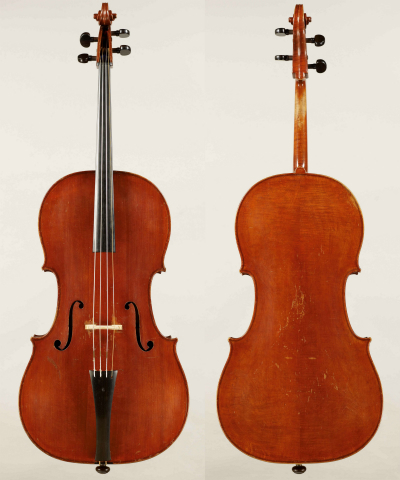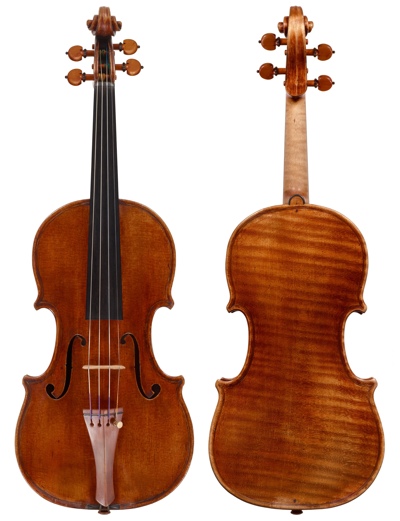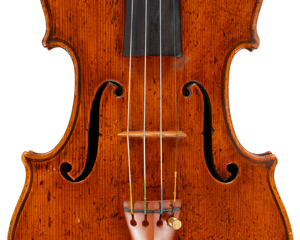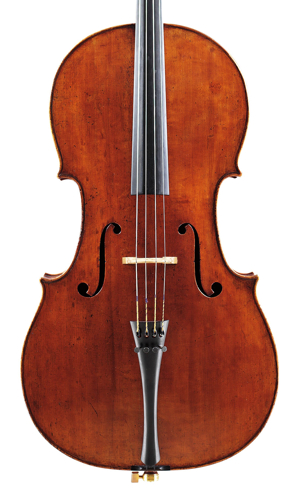Italian violin makers are famous for their creativity and versatility. From the days of Andrea Amati they produced a mind-boggling array of variations on the same basic theme. This diversity is the fundamental hallmark of Italian violin making and, as a result, identifying the greatest old instruments is both fascinating and challenging. Practically every maker’s work is individual enough, even within the same school and period, to make it unique and identifiable. Minor or major misattribution only happens as a result of our lack of knowledge, aided by the long-standing practice of relabeling instruments, and by the rarity of these instruments themselves.

This Gennaro Gagliano example from c. 1767 shows his adoption of the Stradivari ‘forma B’ cello model
Italian makers – including Stradivari – were adept at creating their own models based on the work of their direct predecessors, but copying directly or even indirectly was never high on their agenda and those copies that do exist are normally not highly reminiscent of the prototypes by today’s standard. What is interesting is that both during Stradivari’s life and for a time after his death in 1737, his style was neither understood nor widely copied. Once the classical Cremonese period had ended in the mid-18th century, most Italian violin making centers focused on the styles of Amati and Stainer. This nevertheless provided some outstanding results from makers such as Pietro Guarneri, Domenico Montagnana, David Tecchler, Carlo Ferdinando Landolfi, Carlo Tononi, Matteo Goffriller and a few others. Even those instruments that Stradivari’s own sons, Francesco and Omobono, made after his death are generally faithful in concept to those of their father, but still have a unique character and are distinctly recognizable.
Antonio Stradivari was without doubt far ahead of his time. It took decades of musical evolution for his mastery to be fully acknowledged, and even longer for that of the other Cremonese genius, Guarneri ‘del Gesù’. Italian makers in the 18th century rarely copied Stradivari, probably because contemporary musicians seemed interested in instruments with a mellower sonority, which were perhaps more easily controlled, but also because few makers could match his meticulous craftsmanship. Another factor was likely the Austrian domination of the northern Italian states at the time and their imposition of Austrian ways and culture, which would naturally favor Stainer. Even those excellent later 18th-century makers who did pay heed to Stradivari’s work appear to have been handicapped by the absence of appropriate tools and varnishes, and possibly by lack of access to the original instruments. However, these makers’ efforts, as we shall see, helped to keep the Cremonese flame alive and collectively they played an important part in the process by which the Stradivari influence had eclipsed that of Jacob Stainer by the end of the 18th century, and eventually would outdo Amati too.
One notable exception was Gennaro Gagliano of Naples, who made excellent Stradivari ‘copies’ perhaps as early as 1740 – some complete with imitation Stradivari labels. There must have been a number of Strads in Naples at the time, as Gagliano also brought out some of the earliest copies of the Stradivari ‘forma B’ cello. His equally skilled brother, Nicolò, was more inclined to copy Amati, though he also dabbled in Stradivari models. Strad copies by both brothers are highly characteristic and easily recognizable as being by the Gaglianos – apart from the well-executed Stradivari form and arching, in their finer detailing and varnish they have little in common with the real thing. The later exponents of the Gagliano family continued to base their instruments on their ancestors’ work rather than that of Stradivari. This, together with a general decline in the quality of output from the Gagliano makers during the 19th century, led to an almost total abandonment of the Strad model in Naples.
One of the earliest attempts by a violin maker to copy Stradivari in a territory where Stainer reigned supreme was the Englishman Daniel Parker, who worked in London during the first third of the 18th century. Parker based his best instruments on the ‘long pattern’ Strad model, which was employed by Stradivari in the last decade of the 17th century, probably because he had had the opportunity to study one or more of these violins. His departure from the English Stainer tradition in favor of Stradivari (including attempting to imitate Strad varnish) was audacious and admirable, but his ability and knowledge of Cremona were rather limited and hindered his capacity to influence other English makers. He remains a fascinating footnote, rather than a key player in this story.
One important maker to be converted to the Strad pattern and help spread it outside Italy was Vincenzo Trusiano Panormo, who is today the most highly valued ‘English’ maker. Panormo had learned about the Stradivari model second hand, possibly in Naples. He spent time in Paris between around 1779 and 1789, when his workshop was close to that of Léopold Renaudin, another early adopter of the Strad model. He also worked in London at some stage in the 1770s and again from 1791. Panormo’s employer John Betts and other makers such as Bernard Simon Fendt and Benjamin Banks also developed Strad models and between them had given a new direction to British violin making by 1800.
A little earlier in Spain, another pioneering champion of the Stradivari style had emerged: José Contreras of Granada and Madrid, often referred to as the ‘Spanish Stradivari’. He was exposed to Stradivari’s work through the Spanish court and by the mid-18th century was producing excellent instruments based on the Strad model. Of the early imitators of Stradivari, he was perhaps the most convincing, having had the opportunity to copy directly from the originals. One of his most famous and interesting contributions is the replacement top and scroll made for the Stradivari cello of 1717 known as the ‘Amaryllis Fleming’, in which he displayed an uncanny ability to imitate the varnish and the model of the original to such a high level that it leaves one wondering whether he had also made a back and sides for the original Stradivari top in order to get two ‘complete’ Strads. Spanish violin making, though relatively small in scale, generally remained free of the Stainer influence.
As the 18th century progressed, there were important developments back in Italy. Nicolò Bergonzi and Lorenzo Storioni, who flourished in Cremona from around 1770, show some familiarity with the Stradivari and Guarneri working methods, inheriting vestiges of their style and flair. Their excellent work is inspired by both of the great makers and indeed they often worked on the Guarneri ‘del Gesù’ model about 50 years before it became widely popularized thanks to the preference of Nicolò Paganini and some other legendary violinists for Guarneri instruments.
Meanwhile in late 18th-century Turin, Giovanni Battista Guadagnini, who appears to have had no direct connection to Stradivari or Cremonese methods, was commissioned by Count Cozio to copy the Stradivari instruments from his collection, which he had acquired from Paolo Stradivari in 1775. This exercise brought us the highly esteemed Turin Guadagninis, which are loosely based on the later Stradivari workshop principles, yet are entirely individual and ironically would probably meet with scant approval at any modern violin making competition.
However, as far as Italian violin making was concerned, the richness of the 18th century would give way to the much more fallow 19th century. Italy’s tumultuous history under French and Austrian rule and its painful eventual unification in 1871 resulted in a slower transition towards industrialization than elsewhere in Europe. Perhaps as a result, in Italy the 19th century produced relatively few great violin makers apart from a few notable exceptions including Giovanni Francesco Pressenda and Giuseppe Rocca.

One of the late Turin works by G.B. Guadagnini, the ‘Maazel’ of 1783 is loosely based on Stradivarian principles
Pressenda, who began his career in the 1810s with French-manner Strad models, later fused the Stradivari and Guarneri patterns to form his own model. Rocca’s style is clearly defined by the same two prototypes, though without Pressenda’s fusion; he skilfully made copies of two instruments shown to him by Luigi Tarisio in the early 1840s, the ‘Messiah’ Strad and, less frequently, the ‘Alard’ Guarneri ‘del Gesù’. Rocca used these models liberally throughout the rest of his life. His were probably the first and the most compelling Italian models of Strad and ‘del Gesù’ since Gennaro Gagliano’s of almost a hundred years earlier.
The imitation game was sporadically alive elsewhere in Italy. Two less well-known 19th-century makers who were inspired by classical Cremona were Antonio Gibertini (1797–1866) and Ludovico Rastelli (1801–1878) in Genoa. Both had built a few Guarneri-modeled instruments, mostly because Paganini’s ‘Il Cannone’ had been revered in that city since the early 19th century, and they were probably encouraged by their clientele to emulate it, though their copies show only a basic, sometimes exaggerated, Guarneri pattern and miss the original by a mile in nearly all other aspects. This was the general later trend of the modern Genoese school, continued by Eugenio Praga, Enrico Rocca, Cesare Candi and all the future Italian imitators of ‘Il Cannone’.
There were undoubtedly other Italian makers in the 19th century making under the loose inspiration of Stradivari, including the later Gaglianos, Andrea Postacchini, Giuseppe Baldantoni and Giuseppe Dal Aglio. But overall Italy’s production in the later 19th century could be seen as school-less, second rate and haphazard. It was therefore fortuitous that outside Italian violin making during this same period, there was a surge in both quality and quantity of production.
In part 2, Dmitry Gindin looks at how the Cremona influence continued its spread in the 19th century.
Dmitry Gindin is an expert, consultant and author of The Late Cremonese Violin Makers. The articles in this series are adopted from his forthcoming book on a selection of the greatest modern Italian violin makers, featuring high-quality photographs of iconic and interesting examples.

